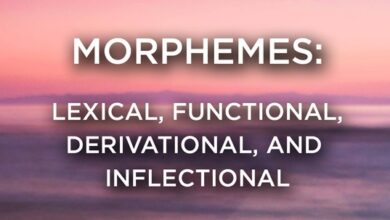Difference between morph and Allomorph
Morph
In linguistics, a morph is a word segment that represents one morpheme (the smallest unit of language that has meaning) in sound or writing. For example, the word infamous is made up of three morphs—in-, fam(e), -eous—each of which represents one morpheme. Here we will define the difference between morph and Allomorph.
A morph (from the Greek word morphē, which means “form” or “shape”) represents the formation of a morpheme, or rather its phonetic realization; an allomorph presents the way that morpheme might sound when pronounced in a specific language or its phonological realization.
A morph is a phonological string (of phonemes) that cannot be broken down into smaller constituents that have a lexicogrammatical function. An allomorph is a morph that has a unique set of grammatical or lexical features. All allomorphs with the same set of features form a morpheme
Allomorph
In linguistics, an allomorph is a variant form of a morpheme, that is, when a unit of meaning varies in sound without changing the meaning. The term allomorph explains the comprehension of phonological variations for specific morphemes.
An allomorph is one of two or more complementary morphs which manifest a morpheme in its different phonological or morphological environments. The plural morpheme in English, usually written as ‘-s’, has at least three allomorphs: [-s] as in [hQts] ‘hats’
Difference between morphs and allomorphs
In morphology, morphemes are the smallest, indivisible units of a word that have lexical and grammatical meaning. Morphs and allomorphs are the phonological manifestations of a morpheme. A morph (from the Greek word morphē, which means “form” or “shape”) represents the formation of a morpheme, or rather its phonetic realization; an allomorph presents the way that morpheme might sound when pronounced in a specific language or its phonological realization. In the book The Oxford English Grammar by Sidney Greenbaum, the differentiation between morphs and allomorphs is described as follows:
When a morpheme is represented by a segment, that segment is a morph. If a morpheme can be represented by more than one morph, the morphs are allomorphs of the same morpheme: the prefixes in- (insane), il- (illegible), im- (impossible), ir- (irregular) are allomorphs of the same negative morpheme.
For example, the English plural consists of three different morphs, which makes it an allomorph because there are several alternatives:
- /s/ – cats
- /z/ – gloves
- [əz] – wishes
As you can see, the “s” makes a different sound in each of the above examples.
Morphs and allomorphs are both ways to describe the phonetic expressions (that is, the actual sounds produced) of the smallest meaningful parts of language in the study of morphology: morphemes.
A word like “unhappy” has two meaningful pieces: “un” and “happy,” which together convey the meaning “not happy.” Each of the meaningful parts is a morpheme, the phonetic expression of which is called a morph. Morphs can be further classified into “lexical” or “grammatical”: lexical morphs are the meaningful roots, like “happy” or “man,” and these are often free-standing words. Grammatical morphs modify the root in a meaningful way, but may not stand as a free word; in English, suffixes like [-able] or prefixes like [un-] are grammatical morphs.
Allomorphs are phonetic variants of a morph. A good example of allomorphy is the plural suffix in English, which can have the allomorphs [-s], [-z], or [-ez] depending on the phonetic environment.
One way of looking at this is that any allomorph is simply what you call a morph that has another possible phonetic expression.
We hope that you have understood the difference between morph and Allomorph.
